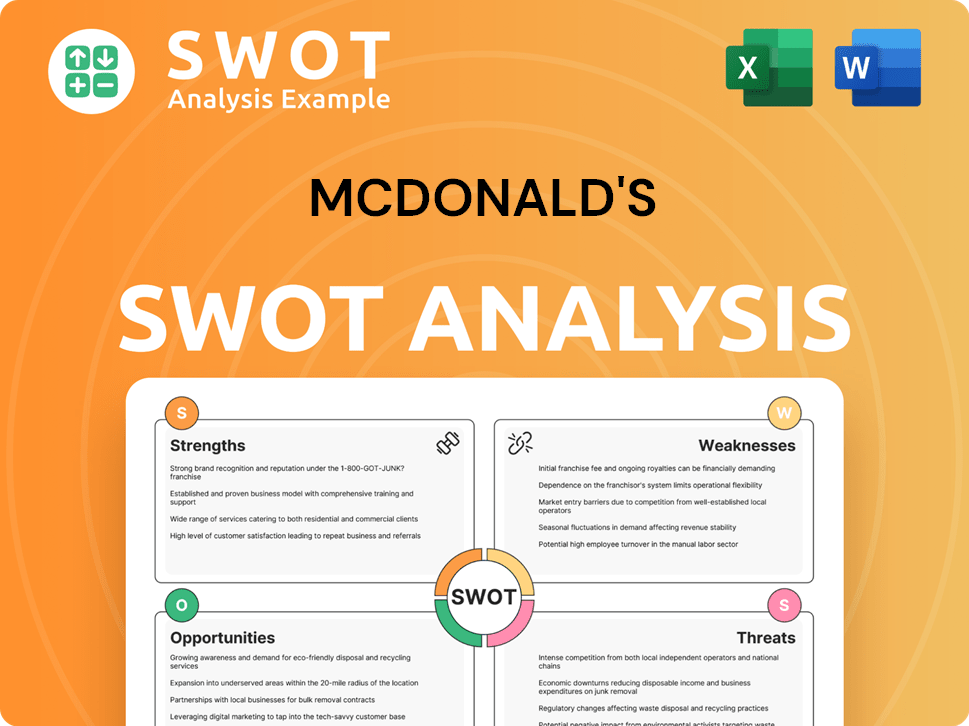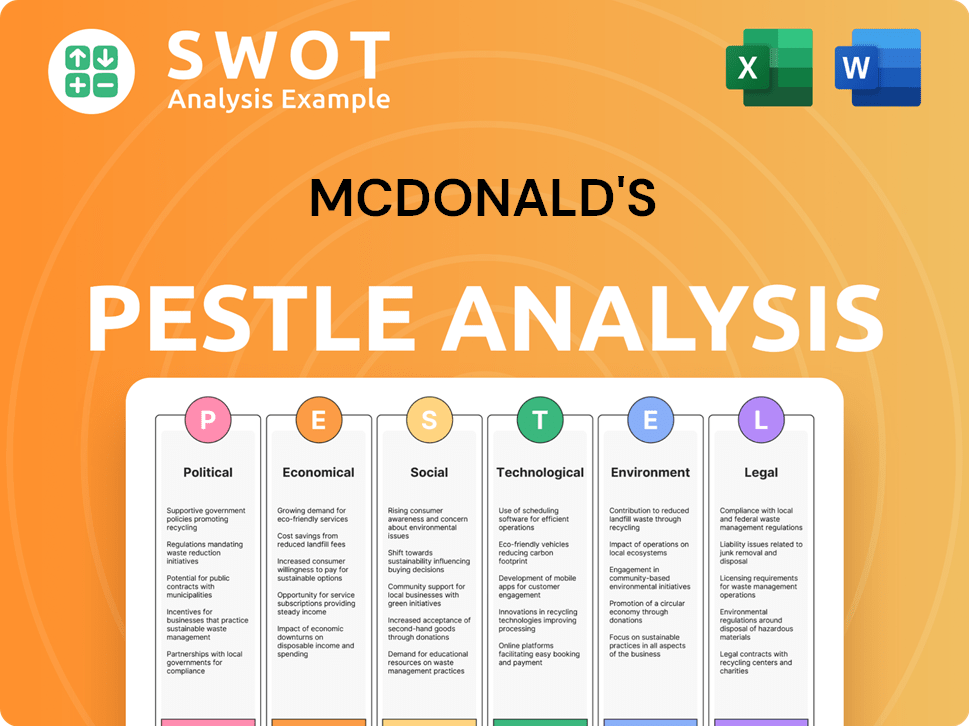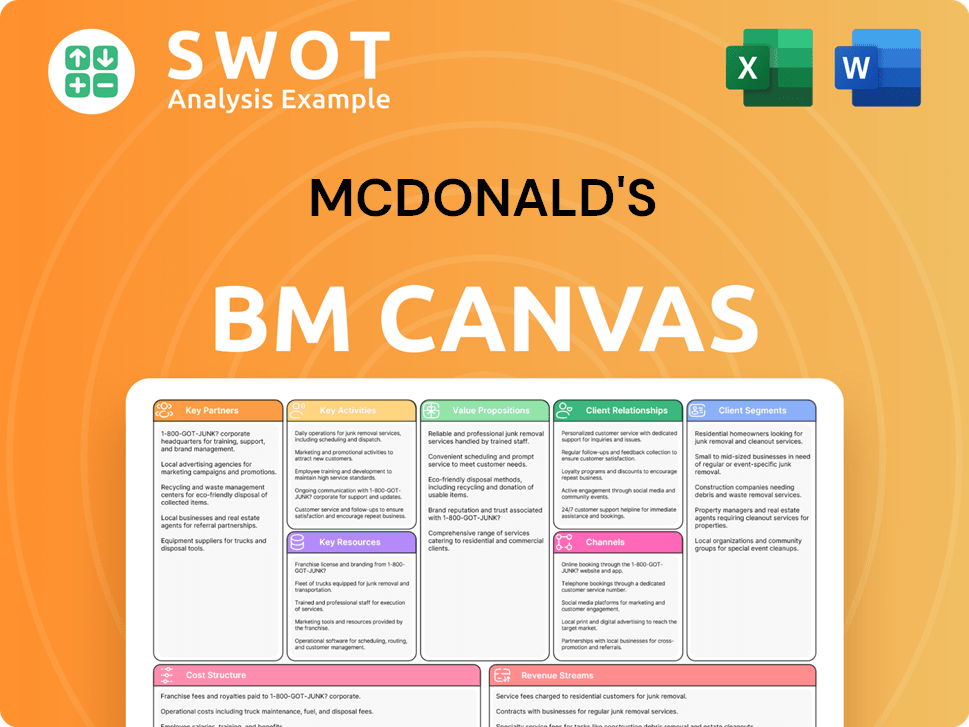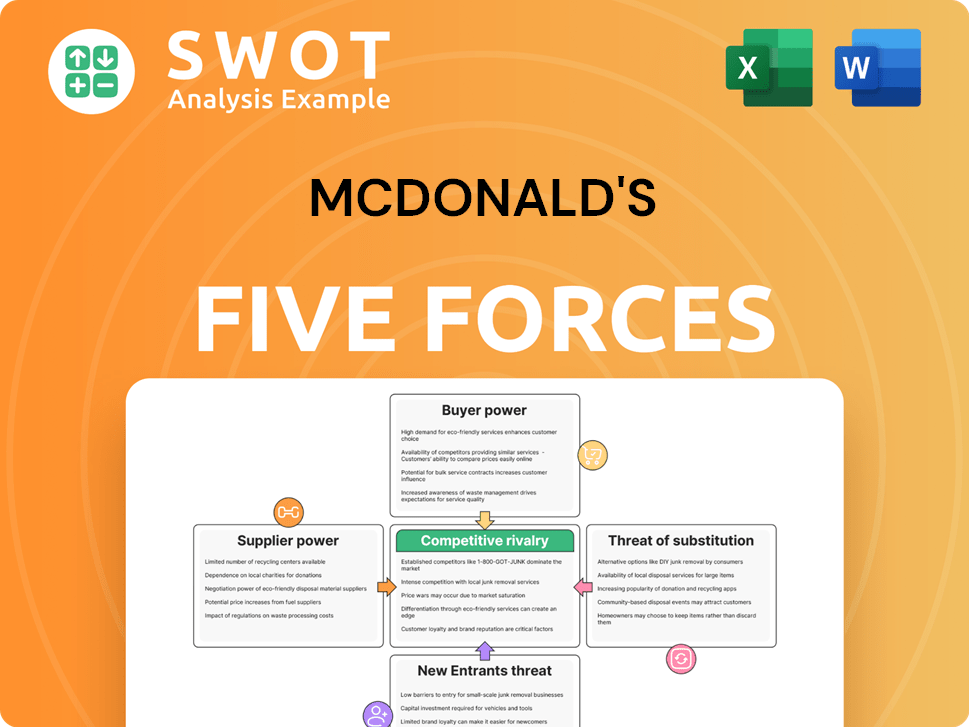McDonald's Bundle
How Does McDonald's Dominate the Fast Food Industry?
McDonald's, a global icon, isn't just a restaurant; it's a complex business machine. With billions in revenue and a presence in countless countries, understanding McDonald's SWOT Analysis is crucial for anyone interested in business, investing, or the fast food industry. This exploration unveils the inner workings of a company that has shaped the way the world eats.

From its humble beginnings, McDonald's has evolved into a masterclass in franchising and operational efficiency. This in-depth analysis will dissect McDonald's business model, providing insights into how it generates revenue, manages its vast supply chain, and adapts to the ever-changing demands of the global market. We'll explore the restaurant chain's strategies, from marketing to sustainability initiatives, to understand its enduring success and future prospects, including its global presence and expansion.
What Are the Key Operations Driving McDonald's’s Success?
McDonald's creates and delivers value through its globally recognized quick-service restaurant experience. It offers a consistent menu of popular food items and beverages to a vast customer base. Core products include hamburgers, cheeseburgers, french fries, chicken offerings, breakfast items, and a selection of beverages and desserts. These offerings cater to a broad demographic seeking convenient, affordable, and familiar meal options.
The operational processes enabling these offerings are highly standardized and efficient, which is central to McDonald's success. This includes a meticulously managed global supply chain that ensures consistent quality and availability of ingredients. Technology development plays an increasingly crucial role, with investments in mobile ordering, self-service kiosks, and delivery platforms enhancing the customer experience and operational efficiency. Sales channels are primarily the physical restaurant locations, including drive-thrus, dine-in, and increasingly, digital platforms for delivery and pickup.
What makes McDonald's operations unique and especially effective is its strong emphasis on standardization, coupled with local adaptation. The company maintains rigorous operational standards across its global footprint, ensuring a consistent product and experience, yet it also allows for menu localization to cater to regional tastes and preferences. Its extensive franchising business model is a key differentiator, where independent owner-operators run the majority of restaurants. This robust operational framework translates into customer benefits such as speed of service, predictable quality, and widespread accessibility, solidifying McDonald's market differentiation.
McDonald's offers a diverse menu designed to appeal to a broad customer base. The menu includes core items like burgers, fries, and chicken, as well as breakfast options and desserts. Menu innovation and regional adaptations are key strategies to maintain customer interest and relevance.
Efficiency is a cornerstone of McDonald's Brief History. The company employs standardized processes, a robust supply chain, and technological advancements to optimize operations. This focus on efficiency allows for quick service and consistent product quality across its global network.
The franchising model is central to McDonald's global expansion strategy. Franchisees operate the majority of restaurants, benefiting from a proven business system and brand recognition. This model allows for rapid growth and lower capital expenditure for the corporation.
Customer service focuses on speed and order accuracy, which is critical for the quick-service model. Digital platforms, such as mobile ordering and delivery services, are increasingly important in enhancing the customer experience and meeting evolving consumer preferences.
McDonald's operations are characterized by standardization, supply chain management, and technological integration. The company's success is built on a foundation of consistent quality, efficient service, and adaptability to local markets. These factors contribute to its strong market position and brand loyalty.
- Standardized processes ensure consistency across locations.
- A global supply chain guarantees ingredient availability and quality.
- Technology enhances the customer experience and operational efficiency.
- Franchising supports rapid expansion and market penetration.
McDonald's SWOT Analysis
- Complete SWOT Breakdown
- Fully Customizable
- Editable in Excel & Word
- Professional Formatting
- Investor-Ready Format

How Does McDonald's Make Money?
The revenue streams and monetization strategies of McDonald's are primarily built on its extensive global restaurant system. The company's financial success hinges on a dual approach: sales from company-operated restaurants and, more significantly, revenues derived from franchised restaurants. In 2023, the total revenues reported by McDonald's exceeded 25 billion U.S. dollars.
The McDonald's business model is heavily reliant on franchising, which contributes the largest portion of its total revenue. This model involves franchisees paying rent, royalties, and fees, providing a stable and predictable income stream for the parent company while reducing operational costs. In 2023, revenues from franchised restaurants reached 15.4 billion U.S. dollars, highlighting the significance of this revenue stream.
Revenue from company-operated restaurants forms the other crucial part of McDonald's operations income. This includes direct sales of food and beverages in restaurants owned and managed by the corporation. In 2023, sales from company-operated restaurants were 9.7 billion U.S. dollars. This segment allows the company to test new products and maintain direct control over brand standards.
McDonald's has invested heavily in digital acceleration, focusing on mobile ordering, loyalty programs, and delivery partnerships to boost customer engagement and order frequency. The 'Accelerating the Arches' strategy, including the MyMcDonald's Rewards program and the McDonald's app, enhances existing sales channels. Strategic partnerships with third-party delivery services expand reach and convenience, contributing to overall revenue growth. For insights into how McDonald's stacks up against its rivals, consider exploring the Competitors Landscape of McDonald's.
- The company's digital investments are expected to significantly contribute to future revenue growth.
- The revenue mix is consistently dominated by the franchised model, reflecting the company's strategic emphasis on this asset-light approach.
- These strategies enhance existing sales channels and contribute to overall revenue growth.
- The company continues to expand its digital and delivery capabilities.
McDonald's PESTLE Analysis
- Covers All 6 PESTLE Categories
- No Research Needed – Save Hours of Work
- Built by Experts, Trusted by Consultants
- Instant Download, Ready to Use
- 100% Editable, Fully Customizable

Which Strategic Decisions Have Shaped McDonald's’s Business Model?
The journey of McDonald's has been marked by significant milestones and strategic initiatives that have shaped its operations and financial success. A pivotal move was the adoption of its franchising model, enabling rapid global expansion with minimal capital investment. Product introductions, such as the Big Mac and Happy Meal, have become iconic offerings, attracting diverse customer segments. Market entries into various international territories, often through master franchise agreements, were crucial for establishing its global footprint.
The company has navigated operational and market challenges, including evolving consumer preferences for healthier options, intense competition, and supply chain disruptions. McDonald's responded by diversifying its menu, investing in technology for faster service and digital engagement, and strengthening its supply chain resilience. The 'Experience of the Future' initiative involved restaurant modernizations to enhance the customer experience. Understanding Owners & Shareholders of McDonald's is key to grasping the company's structure.
McDonald's competitive advantages are substantial. Its strong brand and global recognition foster immense customer loyalty. Economies of scale in sourcing, production, and marketing provide a significant cost advantage. The extensive global real estate portfolio, owned by the company and leased to franchisees, provides a stable asset base and consistent revenue. The robust franchising system empowers local owner-operators while maintaining brand consistency. McDonald's continues to adapt to trends, such as the demand for convenience and digital interaction, by investing in mobile ordering, delivery services, and personalized marketing.
The Big Mac debuted in 1967, becoming a signature item. The Happy Meal launched in 1979, appealing to children and families. Expansion through franchising allowed for rapid global growth.
Menu diversification to include healthier options and premium items. Investment in technology for mobile ordering and delivery services. Strengthening supply chain resilience to mitigate disruptions.
Unmatched brand strength and global recognition drive customer loyalty. Economies of scale in sourcing and marketing provide cost advantages. A vast real estate portfolio generates consistent revenue.
McDonald's operations are centered around its global network of restaurants, supply chain, and franchise system. The company's business model relies heavily on franchising, with franchisees operating the majority of its restaurants worldwide. The company's supply chain is designed to efficiently deliver ingredients to its restaurants, ensuring consistency and quality. McDonald's operations are also heavily influenced by technological advancements, such as mobile ordering and digital kiosks.
McDonald's continues to demonstrate robust financial performance. In 2024, the company's global systemwide sales reached approximately $125 billion. The company's stock price has shown steady growth, reflecting investor confidence. McDonald's maintains a leading position in the fast-food industry, with a significant market share globally.
- Revenue: In 2024, McDonald's reported revenues of over $25 billion.
- Franchise Model: Over 90% of McDonald's restaurants worldwide are franchised.
- Digital Sales: Digital sales continue to grow, accounting for a significant portion of total sales.
- Global Presence: McDonald's operates in over 100 countries, with over 40,000 locations worldwide.
McDonald's Business Model Canvas
- Complete 9-Block Business Model Canvas
- Effortlessly Communicate Your Business Strategy
- Investor-Ready BMC Format
- 100% Editable and Customizable
- Clear and Structured Layout

How Is McDonald's Positioning Itself for Continued Success?
The global quick-service restaurant industry sees McDonald's holding a dominant position, marked by considerable market share, strong customer loyalty, and extensive global reach. It consistently ranks among the top restaurant chains worldwide by revenue and the number of locations, demonstrating its leadership in a competitive sector. McDonald's unparalleled brand recognition significantly contributes to repeat business and customer allegiance.
Despite its strong standing, McDonald's faces risks such as evolving consumer preferences towards healthier options, intense competition from other chains, and regulatory changes. Economic downturns and inflationary pressures also pose challenges. Technological advancements present both opportunities and risks, depending on the company's ability to adapt. Understanding McDonald's business model is key to navigating these challenges.
McDonald's is a leader in the fast food industry, with a substantial market share. Its global presence spans over 100 countries, solidifying its position. The company's strong brand recognition supports its ability to attract and retain customers.
Evolving consumer preferences towards healthier food options present a challenge. Intense competition from other QSR chains and fast-casual restaurants also poses a threat. Regulatory changes and economic downturns can impact operations and profitability. The Growth Strategy of McDonald's is crucial for adapting.
McDonald's focuses on strategic initiatives to sustain growth, including digital platforms and menu innovation. The 'Accelerating the Arches' strategy is key to future expansion. The company aims to deliver value to customers and shareholders through operational excellence.
The company continues to invest in digital platforms for enhanced customer experience. Menu evolution and new restaurant formats are being explored. McDonald's leverages its scale and brand strength to drive continued growth.
In 2023, McDonald's reported global systemwide sales of over $116 billion. The company operates through a franchising model, with a significant portion of restaurants being franchised. McDonald's operations include a complex supply chain and a focus on customer service.
- The company's revenue in 2023 was approximately $25.4 billion.
- Approximately 95% of McDonald's restaurants worldwide are franchised.
- Digital sales continue to increase, representing a significant portion of overall sales.
- McDonald's is investing in technologies to improve efficiency and customer experience.
McDonald's Porter's Five Forces Analysis
- Covers All 5 Competitive Forces in Detail
- Structured for Consultants, Students, and Founders
- 100% Editable in Microsoft Word & Excel
- Instant Digital Download – Use Immediately
- Compatible with Mac & PC – Fully Unlocked

Related Blogs
- What are Mission Vision & Core Values of McDonald's Company?
- What is Competitive Landscape of McDonald's Company?
- What is Growth Strategy and Future Prospects of McDonald's Company?
- What is Sales and Marketing Strategy of McDonald's Company?
- What is Brief History of McDonald's Company?
- Who Owns McDonald's Company?
- What is Customer Demographics and Target Market of McDonald's Company?
Disclaimer
All information, articles, and product details provided on this website are for general informational and educational purposes only. We do not claim any ownership over, nor do we intend to infringe upon, any trademarks, copyrights, logos, brand names, or other intellectual property mentioned or depicted on this site. Such intellectual property remains the property of its respective owners, and any references here are made solely for identification or informational purposes, without implying any affiliation, endorsement, or partnership.
We make no representations or warranties, express or implied, regarding the accuracy, completeness, or suitability of any content or products presented. Nothing on this website should be construed as legal, tax, investment, financial, medical, or other professional advice. In addition, no part of this site—including articles or product references—constitutes a solicitation, recommendation, endorsement, advertisement, or offer to buy or sell any securities, franchises, or other financial instruments, particularly in jurisdictions where such activity would be unlawful.
All content is of a general nature and may not address the specific circumstances of any individual or entity. It is not a substitute for professional advice or services. Any actions you take based on the information provided here are strictly at your own risk. You accept full responsibility for any decisions or outcomes arising from your use of this website and agree to release us from any liability in connection with your use of, or reliance upon, the content or products found herein.